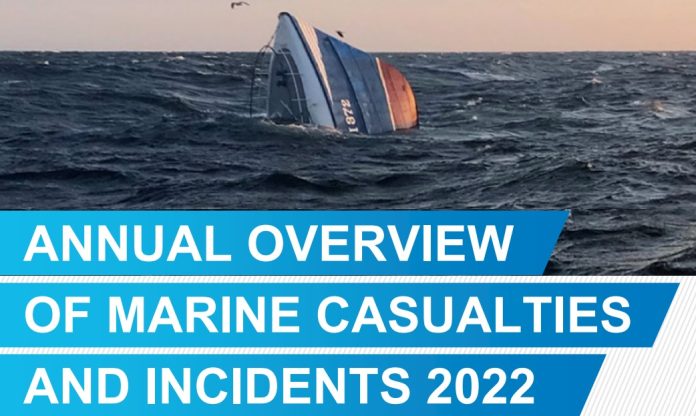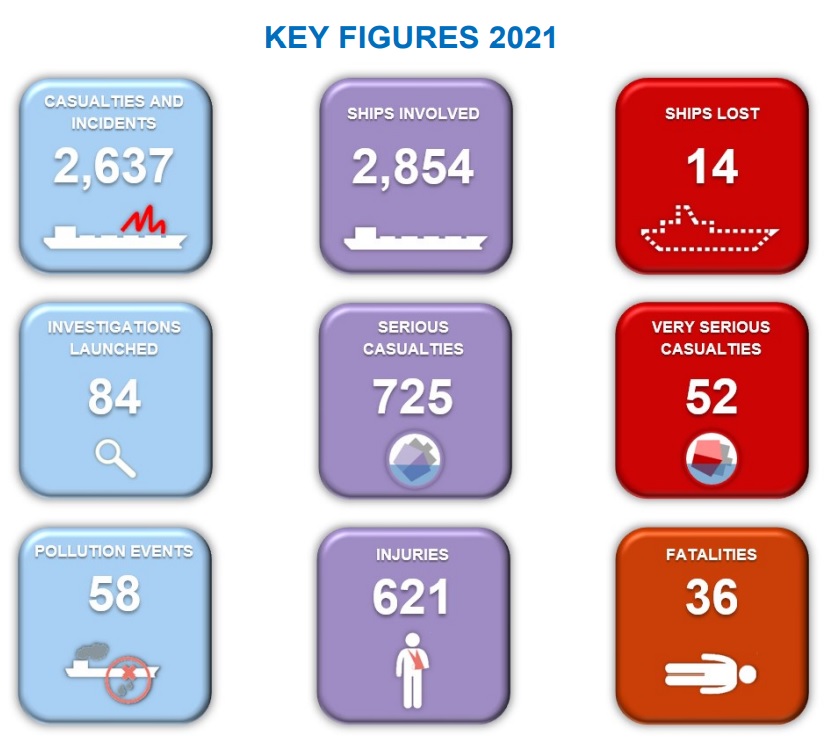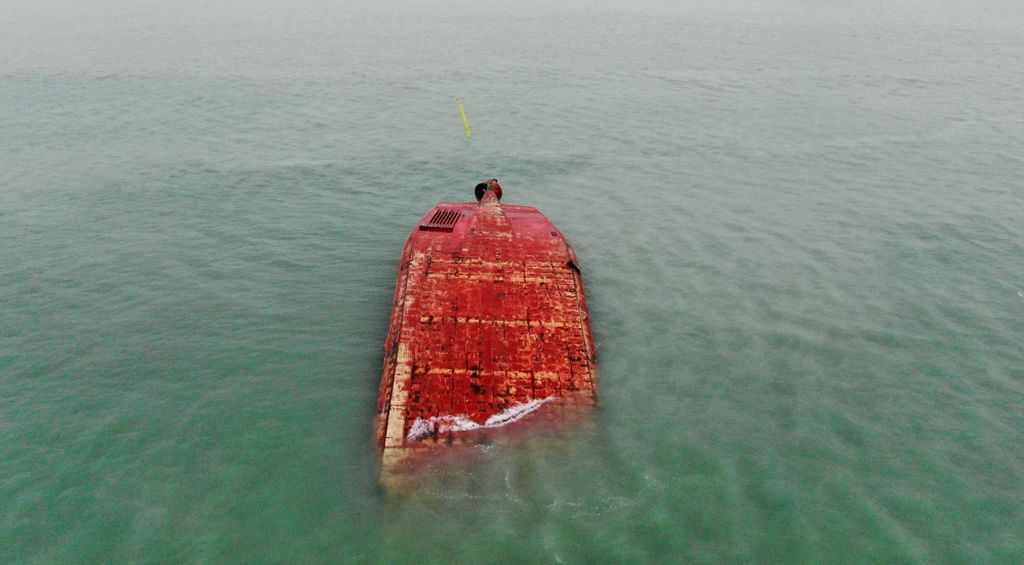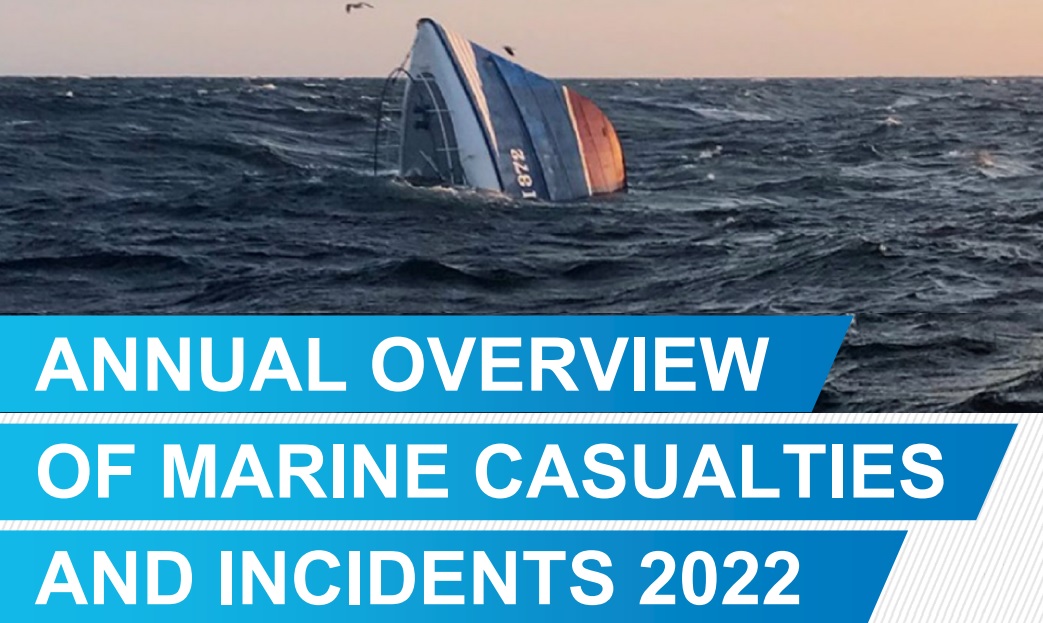
(www.MaritimeCyprus.com) This publication presents statistics on marine casualties and incidents which involved ships flying a flag of one of the EU Member States and occurred within EU Member States’ territorial sea or internal waters as defined in UNCLOS or involved substantial interests of EU Member States, as reported by Member States in the EU database for maritime incidents EMCIP (European Marine Casualty Information Platform).
In this document EU and EU Member States are the 27 EU Member States plus the EEA EFTA States (Iceland and Norway) to which the Directive applies. EU 27 is used explicitly when referring to the 27 EU Member States without the EEA EFTA States. The figures from EMCIP database cover the period from 1st of January 2014 to 31st of December 2021.
Data from 2014 to 2020 have been re-analysed to consider only the marine casualties and incidents involving at least one of the EU Members States (EU 27 plus EEA EFTA). There was a small reduction in the number of marine casualties and incidents considering 27 Member States instead of 28, but trends and conclusions are very similar, confirming that reporting is a global work without primacy of any Member State.
2021 appeared to have been a positive year considering the reduction and stabilisation of most of the indicators, such as the number of occurrences, ships lost, fatalities or injuries. After traffic reduction in 2020, due to COVID pandemic, traffic increased in 2021 and cruise ships and ferries activities started again, but pre-COVID levels were not reached.

In 2021, 2,637 marine casualties and incidents were reported, representing a reduction of 166 marine casualties and incidents in comparison with the year 2019, after a 6-year period of stable number of occurrences (average of 2,665 casualties between 2014 and 2019). In 2020, there was an exceptional decrease of 200 marine casualties and incidents compared to year 2019. With an increase of 90 marine casualties between 2020 and 2021, the number of marine casualties and incidents in 2021 was still under the average number of occurrences before the pandemic. The total number of marine casualties and incidents reported in the period from 2014 to 2021 was 21,173.
In 2021, the number of ships involved in marine casualties and incidents increased in comparison with 2020 and decreased in comparison to 2019 for all ship types except fishing vessels. For fishing vessels, the number of ships involved in marine casualties and incidents in 2021 decreased in comparison to 2020 and increased in comparison to 2019.
After a peak of 106 very serious casualties reported in 2018 and a total of 75 in 2019, the number of very serious marine casualties was 51 in 2020 and 52 in 2021, confirming the reduction in the trend.
To draw objective comparisons between the different ship types, ratios between the number of marine casualties and incidents involving each ship type and its corresponding fleet size were calculated. These ratios are called ship occurrence indicators (see Appendix 4). Due to data availability, indicators calculations were limited to ships flying an EU 27 Flag, and with an IMO number when it related to cargo ships, passenger ships and service ships. For fishing vessels, only EU 27 flag vessels with a length above 15 meters were considered.
Ship occurrence indicators show the number of marine casualties and incidents in one year per one thousand EU27 flag ships under the scope of Directive 2009/18/EC. The average ship occurrence indicator in the period from 2014 to 2021 was 115, with a maximum of 125 in 2020, a minimum of 99 in 2020 and 108 in 2021. Both passenger ships and cargo ships had the greater average ship occurrence indicators, 191 and 152 respectively.
However, a decrease of annual indicators was observed since 2015 for both ship types. Regarding service ships, this category had the lowest indicator, with an average of 38 occurrences over the period from 2014 to 2021. Finally, the occurrence indicator about fishing vessels was 51 with an increase over the period from 2014 to 2021.
From 2014 to 2021, internal waters (port area and other) were the locations where more than half of the reported marine casualties and incidents took place, followed by territorial sea and open sea. From 2014 to 2021, departure phase was the segment of a voyage with the lowest average, 8.4% of the ships involved in marine casualties and incidents, and ‘en route’ portion was the one with a higher average, with an average of 44.0% of the ships involved in marine casualties and incidents. 45.3% of the ships involved in marine casualties and incidents were in departure, arrival, anchored or alongside voyage segments, in internal waters.
10.8% of the ships involved in marine casualties and incidents were in unknown voyage segments.

EU waters in North Atlantic, with an average of 19.5% of the marine casualties and incidents, and EU waters in Mediterranean Sea, with an average of 14.3% of the marine casualties and incidents, were the geographical areas with the higher number of occurrences, with an exception for passenger ships with a greater number of occurrences in EU waters: being in the Mediterranean Sea and the Baltic Sea.
After a decrease in the traffic density around Europe in 2020, more intense for passenger ships than for cargo ships and fishing vessels, traffic density values increased again in 2021 with values still under the levels in 2019.
EU Member States investigative bodies have launched 984 investigations over the period from 2014 to 2021 and 832 safety investigation reports were made public. In 2021, 84 investigations were reported to have been launched, meaning a decrease of 7.7% in comparison with the year 2020 and a decrease of 28.2% in comparison with the year 2019.
From 2014 to 2021, there was a total of 563 lives lost in 376 marine casualties. After a continuous important decrease until 2017 when 45 fatalities were recorded, an increase up to 67 was recorded in 2019. 43 fatalities were recorded in 2020 and 36 in 2021. 89.3% of the victims were crew members. The main event resulting in fatalities was collision, when it related to a ship, and slipping / falls when it related to a person.
From 2014 to 2021, there was a total of 6,155 injuries in 5,394 marine casualties and incidents. From 2014 to 2019 the average of injuries was 825, there was a decrease to 587 in 2020 and a new increase to 621 in 2021, a 25.8% less injuries than in 2019. 84.6% of the injuries were crew members. The main event resulting in injuries was collision, when it related to a ship, and slipping / falls when it related to a person.
Fatalities and injuries indicators based on the number of the person on board for each person category (crew member, passenger or other) in the EU fleet were developed. The trends of these indicators for crew and passengers were like the trends in number of fatalities and injuries.
In 2021, 14 ships were lost, 650 ships were damaged, 219 ships were considered unfit to proceed, 759 required shore assistance, 368 ships required towing and 21 ships were abandoned. There were 340 Search and Rescue (SAR) operations. In general, this means a reduction in the consequences to ships, in comparison with previous years and an increase in the support to vessels after the marine accidents and incidents.
For even more information, click on below image to download full EMSA report (64p).
Source: EMSA















